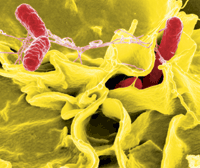A new approach to poultry disease testing offers quicker diagnosis

A breakthrough in testing is set to make poultry disease diagnosis even quicker. Rob Harrison explains how
A testing service launched by a new company is set to make the identification of common diseases in pigs and poultry “quicker and more specific”.
Molecular Diagnostic Testing, in Craven Arms, Shropshire, uses polymerase chain reaction (PCR) methods to detect bacterial and viral DNA and RNA. But how does this work and how does it differ from existing methods of detecting disease?
• What is PCR?
DNA and RNA are unique to each type of organism and can be used to identify the presence of a particular pathogen. The process takes this DNA or RNA and multiplies each unique strand to produce millions of identical copies which can be detected by testing kits.
• What does a PCR test tell you?
The PCR test allows the accurate and specific identification of a target organism from a section of its genetic code. This means rapid identification can be made, even if incredibly small numbers of the organism are present, or if the organism is in a nonviable state (dead or unable to grow). Traditional culture techniques are unable to identify pathogens in this state or at these low numbers.
PCR testing can also be used to identify bacteria isolated using routine cultural techniques, such as salmonella, listeria and campylobacter, to name a few.
• What are the advantages?
The first benefit is the speed of the result, which can give results within a few hours. A second benefit is the limit of detection can be much more sensitive using the PCR depending on sample type and test.
It can target a specific group of organisms or can be designed to detect specific species, depending on the type of test kit available. It is possible to design specific assays much quicker than previously with a new PCR being designed in as little as three months, as long as the genetic code for the organism is available.
• How can it benefit producers?
With the example of a laying flock, if a routine test indicated the presence of an infectious bronchitis virus, but it was unsure which one, PCR testing could identify which particular strain was actually present in the bird. This could lead to the modification of the vaccination programme by a vet which could then help prevent the problem occurring in the next flock and so preventing any egg drop and loss of income associated with an egg drop or loss of egg shell colour.
Alternatively if a pathogen such as brachyspira or a virus was suspected, where there is currently no conventional blood test available or the organism is very difficult or expensive to grow, its presence could be identified by PCR, therefore, allowing the vet to treat the animals accordingly.
• What diseases is the new test most useful for?
Diseases where it is especially hard to grow or culture, such as viruses, some bacterial species like brachyspira, parasites such as coccidia and identifying specific bacteria from suspect cultures.
• How significant is this breakthrough in testing?
In the UK, we seem to be much further behind continental Europe where real time PCR testing is now a routine diagnostic tool.
One reason is that the range of kits ready for use has not been pushed or not available in the UK. The “Ready to Use” bit is important as there are kits that have been available, but the quality control and validation had to be carried out by the end user. This makes it not viable on a cost basis for many contract labs. So tests have been limited to Universities and research institutes, hence the poor service and slow turnaround times.
• How do you see disease diagnosis developing in the next five years?
I do not see PCR testing and real time PCR testing in particular replacing conventional high volume testing as currently used. However, I do believe that there will be a shift to using more real time PCR’s for follow up diagnosis, for example where an organism is thought to be present due to an antibody response detected by current lab tests. PCR can then be used to try and prove that the organism is or has been present.
Also bacterial isolates from routine microbiology can be confirmed and identified much more quickly than at present. This could result in an organism being available for autogenous vaccines production much more quickly and with a more definitive identification returning a cost and time saving for producers.
